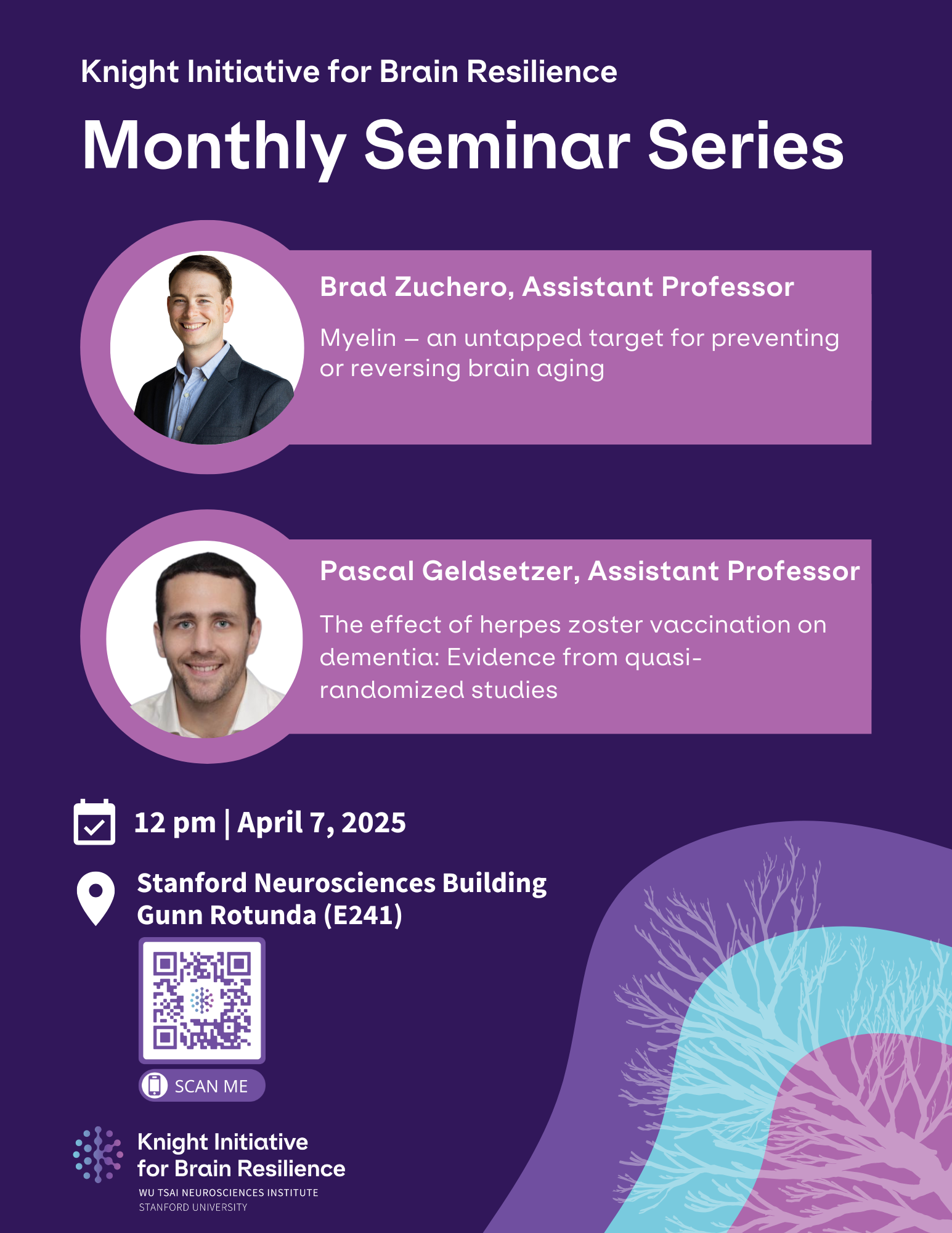The first Monday of each month, the Knight Initiative for Brain Resilience will host monthly seminars to bring together awardees, affiliated professors and students for a series of 'lab meeting' styled talks. Two speakers will discuss their brain resilience research, experiences in the field, and answer questions about their work.
To support our researchers' participation in this open science ‘lab-meeting style’ exchange of ideas, these seminars are not streamed/recorded and are only open to members of the Stanford community.
Brad Zuchero, Stanford University
Myelin – an untapped target for preventing or reversing brain aging
Myelin is essential in vertebrates for rapid nerve signaling, while myelin dysfunction and loss are increasingly found to be hallmarks of neurodegenerative disease and aging. Long-thought to be passive players in CNS disease and aging, recent studies show that myelin-forming oligodendrocytes become activated into a disease-associated oligodendrocyte (DAO) state across multiple neurodegenerative diseases and in the aging brain. However, the signals that induce oligodendrocytes to become activated in disease and aging—and whether these DAOs acquire new functions—remain unknown. We recently discovered that mature oligodendrocytes undergo striking cellular changes in response to a class of signaling molecules secreted by reactive glia. Specifically, these secreted signals induce cultured oligodendrocytes to shed myelin membrane, become motile, and phagocytose myelin debris. Intriguingly, these signals also induce oligodendrocytes to dramatically downregulate myelin genes and upregulate hundreds of genes generally not associated with homeostatic oligodendrocytes, including signature DAO genes and genes implicated in immune cell function. Moreover, after entering a DAO state, these cells can turn back into mature, myelinating oligodendrocytes. We further found that this oligodendrocyte state-change occurs in vivo, including expression of disease markers and disruption of myelin membrane. We are now working to determine the extent to which this signaling pathway plays a role in driving oligodendrocyte cell-state changes in disease models and in aging. This work may unlock a paradigm-shifting view of oligodendrocyte plasticity by revealing a novel mechanism of myelin disruption as well as a pathway by which mature oligodendrocytes could contribute to remyelination in the diseased or aging brain.
Pascal Geldsetzer, Stanford University
The effect of herpes zoster vaccination on dementia: Evidence from quasi-randomized studies
This presentation will discuss evidence from electronic health record data for a protective effect of herpes zoster vaccination on mild cognitive impairment, dementia, and deaths due to dementia. To provide causal as opposed to merely correlational evidence, we have taken advantage of the fact that in the United Kingdom eligibility for the herpes zoster vaccine was determined based on an individual’s exact date of birth. Those born before September 2 1933 were ineligible and remained ineligible for life, while those born on or after September 2 1933 were eligible to receive the vaccine. By using large-scale data on all vaccinations received, primary and secondary care encounters, death certificates, and patients’ date of birth in weeks, we first show that the percentage of adults who received the vaccine increased from 0.01% among patients who were merely one week too old to be eligible, to 47.2% among those who were just one week younger. Apart from this large difference in the probability of ever receiving the herpes zoster vaccine, there is no plausible reason why those born just one week prior to September 2 1933 should differ systematically from those born one week later. This unique natural randomization, thus, allows for robust causal, rather than correlational, effect estimation. We then show that receiving the herpes zoster vaccine reduced the probability of a new dementia diagnosis over a follow-up period of seven years by approximately 20 percent. Besides preventing herpes zoster and dementia, the herpes zoster vaccine had no effects on any other common causes of morbidity and mortality. I will discuss a series of replications and extensions of this work in other settings and using other data sources.


